
Maqām Festival First Pre-Launch Concert “4000 Years of Maqām Music in the Mediterranean”
Date: 11 May 2025 from 19:00 to 20:10
Location: San Lorenzo Church (indoors), Venice, Italy
The musical traditions of West Asia, North Africa and Medieval Europe are based on a common modal melodic system. The maqām mode of a traditional musical work provides the melodic alphabet and the typical formulas from which the phrasing is elaborated, at the same time as it colors the emotions conveyed, inducing ecstasy. If these great traditions converge on the level of this common melodic system, similar to the trunk of a very old tree, their cultural diversity is expressed by the traces that the prosody of the sung languages and the ritual and choreographic gestures, specific to the contextual cultures, leave in their rhythm and their musical styles and forms, thus generating a multitude of traditional musical branches. Thus, the important anonymous Arabic treatise on musical grammar a-š-Šajaratu ḏāt ul-akmāmi l-ḥāwiyatu ḏāt al-anġām (The Tree With the Calices Bearing the Essences of Modes) uses in the 16th century the modal tree symbol to describe the generative grammar of maqām modes: a maqām 'aṣl, original/fundamental trunk mode, generating maqāmāt furū’ branches-modes and melodic phrases. But this symbol, which is taken up by Goethe (1749-1832) in his Urpflanze (the original plant of all plants), Schenker (1868-1935) in his Ursatz (the original structure of all tonal compositions) and Chomsky in the generative arborescent elaboration of all the sentences of a language, does not but recapitulate the mystical archetype of the Tree of life of the Book of Genesis, becoming the Christic True-Vine in the Gospel of Saint John and the Bright Olivier of the Surah of Light. This mystical dimension is underlined by the etymology of the word maqām (degree) borrowed from Sufism and its maqāmāt, ascetic gradations generating aḥwāl, ecstatic states of divine closeness. This illumination is combined with a healing of the soul and the body, as witnessed by the chronicles of the Arab hospitals where sedative music therapy was practiced, as well as another anonymous Arabic musical treatise of the 16th century that teaches the art of healing various pathologies through the ethos(emotional color) of maqām and its cosmological inscription (elemental and humoral) which induce a ṭarab sedative ecstasy or a ṭarab cathartic trance.
Maqām Festival Ensemble:
Nidaa Abou Mrad, conducting, kemanšē, medieval fiddle and violin
Tarik Beshir, singing and ‘ūd
Rafka Rizk, chanting
Ghassan Sahhab, qānūn and lyre

Professor Nidaa Abou Mrad, MD and PhD in Musicology, is currently Senior Professor of Musicology, Neuropsychology of Music and Music Therapy at Sorbonne Université (Paris), Institut de recherche en Musicologie (UMR 8223), at the same time as the Dean of the Faculty of Music and Musicology at the Antonine University (Lebanon) and the scientific and artistic director of Maqām Festival. He won the 2017 Research Excellence Award of the National Council of Scientific Research in Lebanon. As a violin an fiddle player and as a composer, with twenty audio CDs and his participation in international musical programs, he is specialized in the art music tradition of the Mašriq, from the Abbassid era to the Nahḍa era.
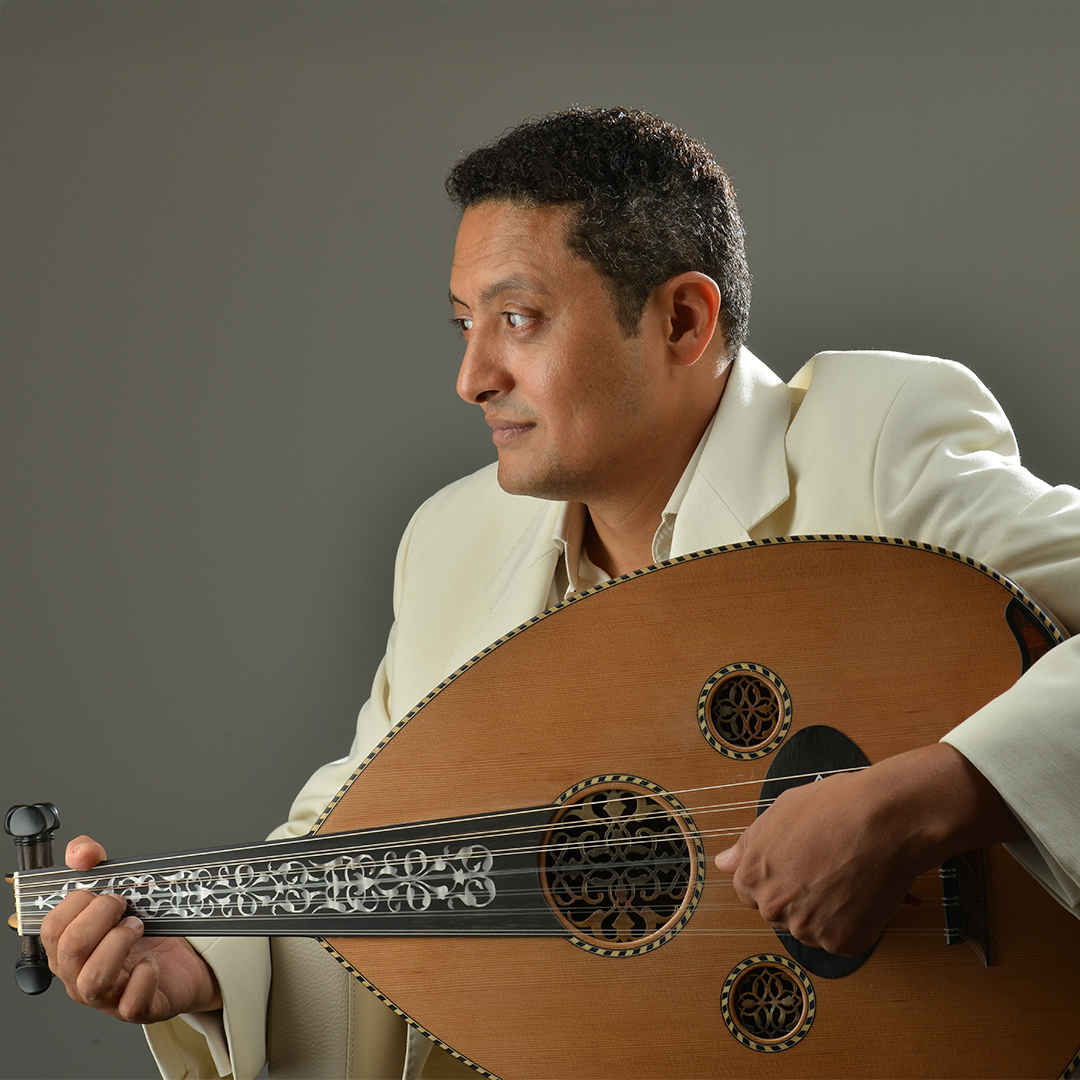
Tarik Beshir is a uniquely talented vocalist and oud player in the style and techniques of the Nahḍa era (1860-1930) classical music in Khedival Egypt. He is one of just a handful who can recreate the sound of this period and is renowned as an expert on the era. He is co-founder of Music Ensemble Oxford Maqam, specialised in the recreation and interpretation of Nahḍa era music (“The Wax Cylinder Recordings” and live performances in reputable theatres through the World), and co-founder of music band Brickwork Lizards (Cinematic Arabic jazz fusion). He was also an arranger and credited Oud performer in two instrumental pieces in the Disney's Aladdin (2019) Film.
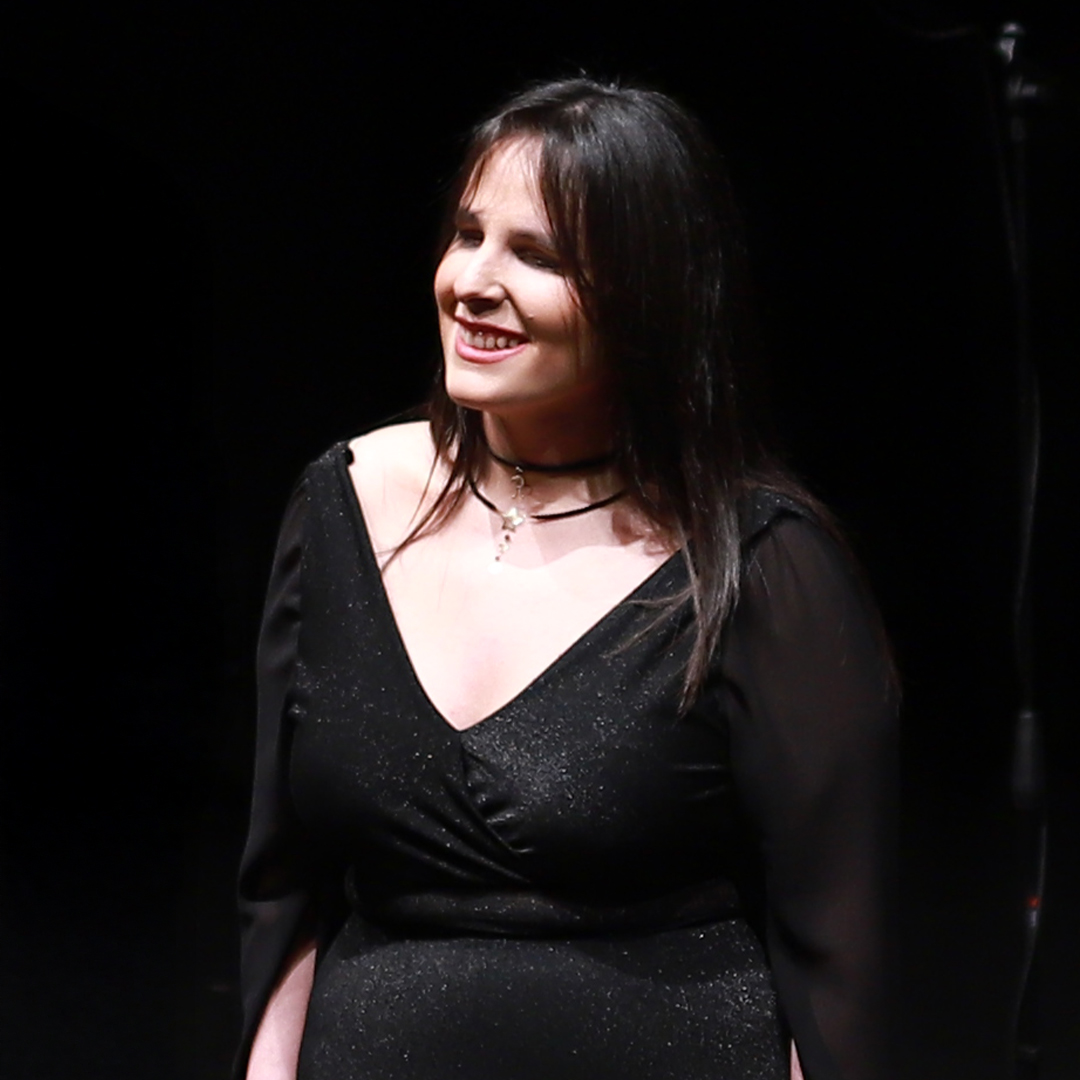
Rafka Rizk, holding a master’s degree in music and musicology from Antonine University, teaches the vocal music tradition of the Nahḍa era at the Faculty of Music and Musicology of Antonine University, being one of the few depositaries of this art in Lebanon.

Dr. Ghassan Sahhab, PhD in Ethnomusicology from Paris-Nanterre Université, is one of the very few instrumentalists in the Arab world to cultivate at a higher level the traditional art of playing qānūn according to the Egyptian Nahḍa tradition, recording CDs and giving live performances in reputable theatres. He is co-founder and musical director of Me‘zaf Initiative (Lebanon) and teaches musicology and qānūn at the Faculty of Music and Musicology of Antonine University.
Program
An initiatory historical musical journey that recapitulates in two parts the arborescence of modal music around the Mediterranean.
The first part of the concert consists of a modal music path through space and time around the Mediterranean Sea, in seven steps.
The first station, that of Antiquity, begins in Ugarit (Syrian coast), around 1500 BC, with the Hurrian Hymn H6, addressed in Nidqibli mode to the goddess Nikkal, the first written music in human history, in cuneiform notation, composed by Urhiya, transcribed by Richard Dumbrill and realized by Nidaa Abou Mrad. This station continues with a Greek hymn of the 1st-2nd century AD, the Epitaph of [the composer] Seikilos, inscribed in alphabetical musical notation on a stele at Tralles in Asia Minor.

Document 1: Hurrian Hymn H6
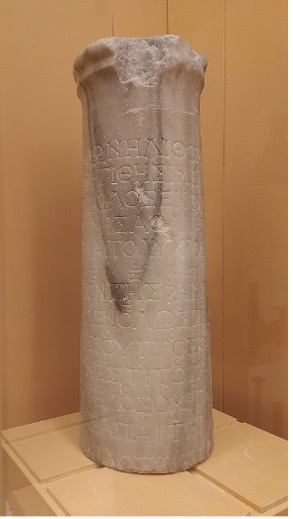
Document 2: Epitaph of Seikilos
The second station is that of ancient and medieval Christian songs: (1) Hymn to the Holy Trinity from the manuscript of Oxyrhynchus (P. Oxy. XV 1786, found in Egypt) of the end of the third century, hymn noted according to the ancient Greek vocal notation, (2) Hymns of the Nativity “Šubhō l-haw qōlō” of the Syriac Maronite and Syriac Orthodox liturgies (oral tradition of Saint Ephrem), (3) Golgotha Hymn of the Coptic Orthodox Holy Week liturgy, (4) Paschal Apolytikion in the Eastern Orthodox Roman Liturgy, (5) Offertorium “Jubilate Deo” in Gregorian chant, interpreted according to the neumatic notation of the Abbey of Saint Gall (9th century), in modal symbiosis with the Oriental Christian chants.

Document 3: Manuscript of Oxyrhynchus, P. Oxy. XV 1786, Sackler Library in Oxford
The third station is that of instrumental and vocal music of the late Abbasid era (based on the alphabetical and numerical musical notation of Ṣafiy ad-Dīn al-Urmawī (1216-1294), transcribed by Nidaa Abou Mrad): (1) Ṭarīqa wa-ṣawt [prelude and singing in mode] min Nawrūz fī ḍarbi r-ramal; (2) Ṭarīqa wa-ṣawt Ḥusaynī ramal on the poem of the Religion of Love by Muḥyi d-Dīn ibn ‘Arabī (1165-1240), musicalized in the Abbasid style by Nidaa Abou Mrad.
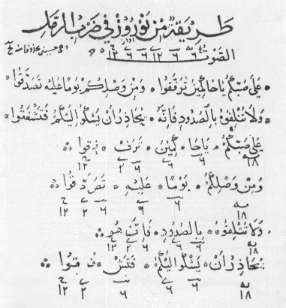
Document 4: Alphabetical and numerical musical notation of Ṭarīqa wa-ṣawt min Nawrūz fī ḍarbi r-ramal, at the end of Ṣafiy ad-Dīn al-Urmawī’s Book of Cycles
The fourth station is that of Maghreb-Andalusian music, with the chanting of the qaṣīda “Arāka ṭarūban”, according to the tradition of the Tunisian Ma’lūf (referring to the interpretation of Aḥmed el-Lawz (1913-1958) which originates in the Arab-Andalusian tradition of Cordoba.
The fifth station is that of the Cantigas de Santa Maria, songs composed in the 13th century by Alfonso the Wise, king of Castile and troubadour, in collaboration with Christian, Muslims and Jews musicians, interpreted here in symbiosis with the modality of maqam: (1) instrumental prelude " La quinte estampie réale " (13th century France), (2) Cantiga 322 “A Virgen”.
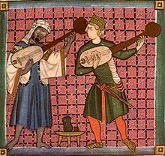
Document 5: Miniature illustrating the collection of Cantigas de Santa Maria
The sixth station is that of the Trecento, with an Italian instrumental music of the 14th century, the Lamento di Tristano (MS Additional 29987, British Library) and a musical paraphrase of the end of Dante Alighieri’s Divine Comedy.
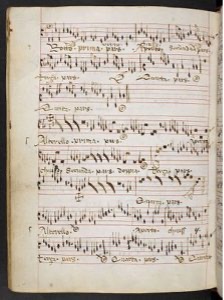
Document 6: The manuscript of Lamento di Tristano (MS Additional 29987, British Library)
The seventh station is that of instrumental and vocal music of the Nahḍa era (Arab cultural renaissance 1798-1939), particularly during the period 1768-1932, in its encounter with Sufism, in its poetry and ecstasies induced by the arborescent spirit of maqām, focusing on the qaṣīda (poem) of the (mystical) “Two Loves” by Rābi'a al-'Adawiyya (713-801).
The second part of the concert is a development in continuity of the seventh station of the first part.

Document 7 : 'Abdu al-Ḥamūlī (1843-1901)
In fact, The Arabic instrumental and vocal art of maqām music has known two golden ages, in the Abbasid era and in the Nahḍa era. The Egyptian singer, improviser and composer 'Abdu al-Ḥamūlī (1843-1901), surrounded by singers and instrumentalists from Egypt and the Levant, replanted the maqām tree in the Nile Valley, after a long period of creative hibernation. Like the endogenous hybridizations that have characterized the reforming dynamics of the Nahḍa in different cultural fields, this revitalization was made by hybridizing four homogeneous musical grafts: (1) the Levantine artistic musical tradition, (2) the Egyptian popular musical tradition (3) the Sufi musical tradition, and (4) the Ottoman artistic musical tradition. From this endogenous mixing comes a hybrid musical form, the waṣla, which is a canonical dialectical path: (I) thesis of measured precomposed (instrumental and vocal) preludes; (II) antithesis of unmeasured improvisations in the cantillation style of taqsīm, yā lēl and mawwāl; (III) synthesis of semi-improvised responsorial vocal forms, performed by the taḫt (a chamber music ensemble).

Document 8: Šayḫ Yūsuf al-Manyalāwī (1850-1911) with Muḥammad al-‘Aqqād’s taḫt
One waṣla will be developed in arborescence from maqām Rāst, with,
I. in thesis, taḥmīla Rāst (semi-improvised instrumental form) and muwaššaḥ “Aḥinnu šawqan” (vocal composition),
II. in antithesis, cantilled improvisation instrumental (taqāsīm) and vocal (“Yā lēl” and mawwāl) in maqām Rāst, and, |
III. in synthesis, dōr (semi-improvised responsorial form) “Aṣli l-ġarām”.
The concert concludes on taqāsīm and dōr “Fī zamāni l-waṣl”, in maqam Nahāwand and Aqṣāq rhythmic cycle (with four irregular pulses).

AEON Collective is a non-profit WAQF driving impact and regenerative development in Saudi Arabia and globally. Through a human-centric, nature-positive approach, we integrate science, culture, and innovation to empower communities and restore balance between people and planet.
TBA21 is a global art and advocacy foundation committed to social and environmental transformation. Through its collection, exhibitions, and Ocean Space in Venice, it supports artists and cultural practices that foster peace, affirm life, and celebrate diversity.
More Programs
Maqām Festival | مُلْتَقَى المُوسِيقَى المَقامِيَّة
P.O. Box 288
Postal Code 12311 Dokki
Giza, Egypt
Tel./whatsapp: +20 109 0379090
info@maqamfestival.com
www.maqamfestival.com
Copyright ©2023-2025 Maqām Festival. All Rights Reserved.
